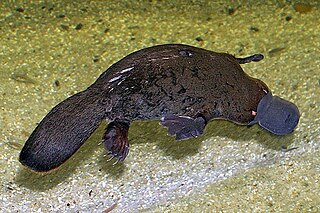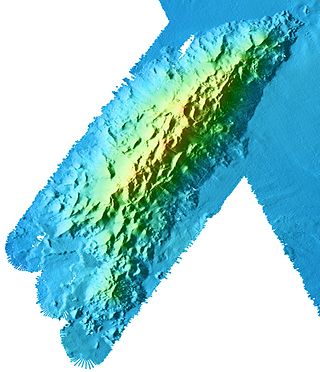Genus is a taxonomic rank used in the biological classification of living and fossil organisms as well as viruses. In the hierarchy of biological classification, genus comes above species and below family. In binomial nomenclature, the genus name forms the first part of the binomial species name for each species within the genus.

Pollock or pollack is the common name used for either of the two species of North Atlantic marine fish in the genus Pollachius. Pollachius pollachius is referred to as pollock in North America, Ireland and the United Kingdom, while Pollachius virens is usually known as saithe or coley in Great Britain and Ireland. Other names for P. pollachius include the Atlantic pollock, European pollock, lieu jaune, and lythe; while P. virens is also known as Boston blue, silver bill, or saithe.

Cecropia is a Neotropical genus consisting of 61 recognized species with a highly distinctive lineage of dioecious trees. The genus consists of pioneer trees in the more or less humid parts of the Neotropics, with the majority of the species being myrmecophytic. Berg and Rosselli state that the genus is characterized by some unusual traits: spathes fully enclosing the flower-bearing parts of the inflorescences until anthesis, patches of dense indumentums (trichilia) producing Mullerian (food) at the base of the petiole, and anthers becoming detached at anthesis. Cecropia is most studied for its ecological role and association with ants. Its classification is controversial; in the past, it has been placed in the Cecropiaceae, Moraceae, or Urticaceae. The modern Angiosperm Phylogeny Group system places the "cecropiacean" group in the Urticaceae.

The Ornithorhynchidae are one of the two extant families in the order Monotremata, and contain the platypus and its extinct relatives. The other family is the Tachyglossidae, or echidnas. Within the Ornithorhynchidae are the genera Monotrematum, Obdurodon, and Ornithorhynchus:
Paleoanthropology or paleo-anthropology is a branch of paleontology and anthropology which seeks to understand the early development of anatomically modern humans, a process known as hominization, through the reconstruction of evolutionary kinship lines within the family Hominidae, working from biological evidence and cultural evidence.

Gregory Scott Paul is an American freelance researcher, author and illustrator who works in paleontology. He is best known for his work and research on theropod dinosaurs and his detailed illustrations, both live and skeletal. Professionally investigating and restoring dinosaurs for three decades, Paul received an on-screen credit as dinosaur specialist on Jurassic Park and Discovery Channel's When Dinosaurs Roamed America and Dinosaur Planet. He is the author and illustrator of Predatory Dinosaurs of the World (1988), The Complete Illustrated Guide to Dinosaur Skeletons (1996), Dinosaurs of the Air (2001), The Princeton Field Guide to Dinosaurs (2010), Gregory S. Paul's Dinosaur Coffee Table Book (2010), The Princeton Field Guide to Dinosaurs: 2nd Edition (2016), The Princeton Field Guide to Pterosaurs (2022), The Princeton Field Guide to Mesozoic Sea Reptiles (2022) and editor of The Scientific American Book of Dinosaurs (2000).

Ferocactus is a genus of large barrel-shaped cacti, mostly with large spines and small flowers. There are about 30 species included in the genus. They are found in the southwestern United States and northwestern Mexico.

Davidsonia is a genus containing three rainforest tree species native to Australia, commonly known as the Davidson plum or Davidson's plum. The fruits superficially resemble the European plum, but are not closely related. All species have an edible sour fruit with burgundy-coloured flesh and are highly regarded as gourmet bushfood.
Zosuchus is a genus of basal, Late Cretaceous crocodyliform from the Mongolia.

Davidson Seamount is a seamount located off the coast of Central California, 80 mi (129 km) southwest of Monterey and 75 mi (121 km) west of San Simeon. At 26 mi (42 km) long and 8 mi (13 km) wide, it is one of the largest known seamounts in the world. From base to crest, the seamount is 7,480 ft (2,280 m) tall, yet its summit is still 4,101 ft (1,250 m) below the sea surface. The seamount is biologically diverse, with 237 species and 27 types of deep-sea coral having been identified.

Cyclotosaurus is an extinct genus of temnospondyl within the family Mastodonsauridae. It was of great size for an amphibian, had an elongated skull up to 56 cm (22 in).

Ilex or holly is a genus of over 570 species of flowering plants in the family Aquifoliaceae, and the only living genus in that family. Ilex has the most species of any woody dioecious angiosperm genus. The species are evergreen or deciduous trees, shrubs, and climbers from tropics to temperate zones worldwide. The type species is Ilex aquifolium, the common European holly used in Christmas decorations and cards.
Verminephrobacter is a genus of Gram-negative bacteria that colonize the nephridia of earthworms within the family Lumbricidae. The first species in the genus, V. eiseniae, was isolated from the earthworm Eisenia foetida, and its description published in 2008. Their closest free-living relatives are bacteria of the genus Acidovorax.

Almas is a genus of troodontid theropod dinosaur from the Late Cretaceous of Mongolia. It contains a single species, Almas ukhaa, named in 2017 by Pei Rui and colleagues, based on a partial articulated skeleton. The only known specimen was found in the Djadochta Formation, which is late Campanian in age.
Salmovirus salmonidallo1, also known as Salmonid herpesvirus 1 (SalHV-1) is a species of virus in the genus Salmonivirus, and family Alloherpesviridae.

Diplacanthus is an extinct genus of Mid to Late Devonian fish in the class Acanthodii, known as spiny sharks.

Terebratulina is a genus of brachiopods belonging to the family Cancellothyrididae. The genus has a cosmopolitan distribution.
Megerlia is a genus of brachiopods belonging to the family Kraussinidae.











